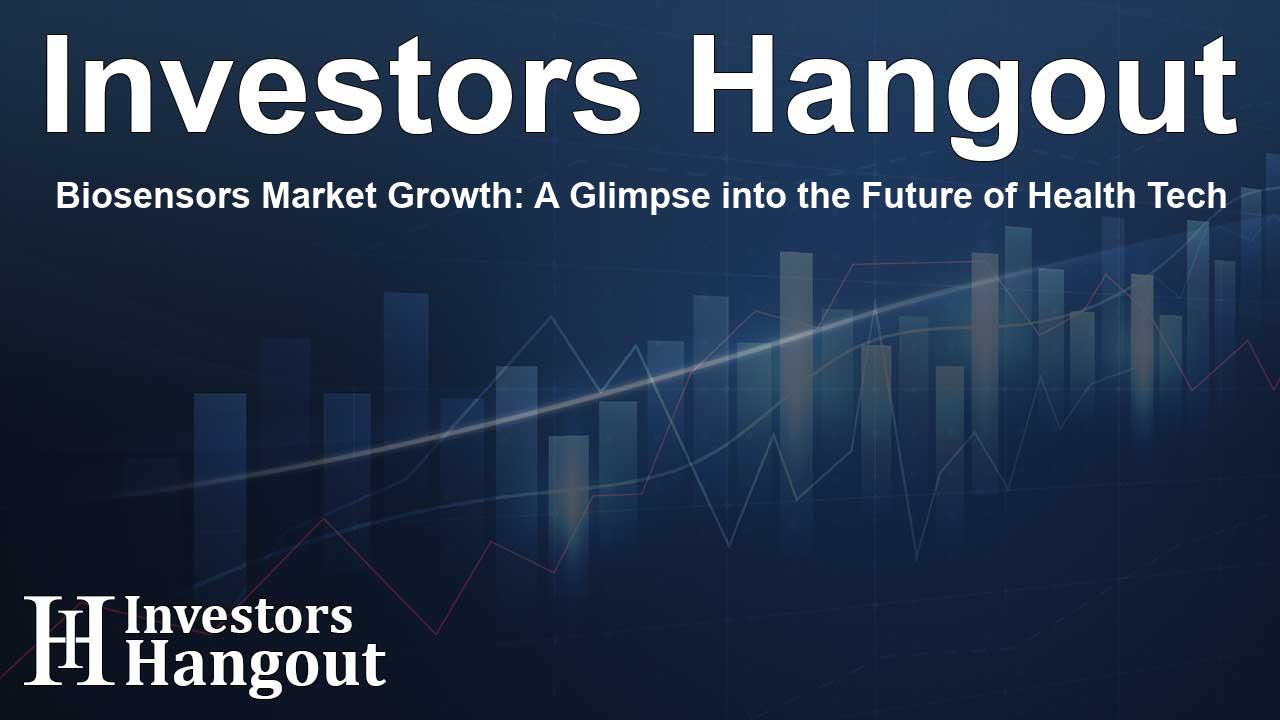Biosensors Market Growth: A Glimpse into the Future of Health Tech

Biosensors Market Growth: A Glimpse into the Future of Health Tech
The global biosensors market is witnessing a significant transformation, projected to attain a valuation of over US$ 75.84 billion by 2033. With a compound annual growth rate (CAGR) of 10.40% predicted from 2025 to 2033, this sector is rapidly evolving due to advancements in wearable technology and increasing consumer demand for health monitoring solutions.
Advancements in Wearable Technology
The landscape of wearable technology has dramatically changed, transitioning from mere lifestyle gadgets to advanced health monitoring systems. Current estimates suggest that one in three individuals in the United States actively employs wearable devices for health and fitness tracking. Despite challenges such as power consumption—where crucial components like microcontrollers and accelerometers drain energy—new energy-efficient designs are being introduced, significantly boosting device battery life from approximately 5 hours to nearly 15 hours.
Enhanced Sensor Capabilities
The latest iterations of wearables now come equipped with a versatile range of sensors, capable of monitoring various biometric indicators such as electromyography (EMG), electroencephalography (EEG), electrocardiogram (ECG), heart rate, blood pressure, and body temperature. Notably, the realm of non-invasive glucose monitoring is witnessing innovative breakthroughs. For instance, a distinctive optical sensor that utilizes 660 nm light has achieved impressive accuracy levels, boasting a Mean Absolute Relative Difference (MARD) of just 8.8% when compared to venous blood samples.
Point-of-Care Testing Revolution
Point-of-Care (POC) testing is redefining the approach to diagnostics, fueled by substantial consumer demand and remarkable technological advancements. With millions of adults living with diabetes worldwide, the market for glucose biosensors is immense, catering to over 336 million potential users. Electrochemical biosensors, which handle a vast proportion of blood tests, can yield results in a mere 8 seconds, marking a significant leap in speed and efficiency.
Efficiency and Multi-Testing Capabilities
The shift towards multiplexing—testing for various pathogens concurrently—is gaining traction. Current platforms can simultaneously detect common sexually transmitted infections and deliver results within 40 minutes for viral testing like Zika. Additionally, next-gen POC devices are under development that will facilitate rapid results across various test classifications, with minimal hands-on time.
Insights on Implantable Biosensors
The segment of implantable biosensors symbolizes a pivotal advance in the quest for ongoing, real-time internal health surveillance. These innovative devices are engineered to monitor vital in-vivo parameters, including tissue oxygenation and pH levels, presenting a unique set of challenges such as biocompatibility issues. Researchers are working tirelessly to address concerns related to biofouling—an accumulation of biological material that can hinder sensor functionality. Emerging technologies aim to enhance device biocompatibility while focusing on longevity through cutting-edge micro-electromechanical systems (MEMS).
Impact of Nanotechnology on Performance
The application of nanotechnology is revolutionizing the biosensors market, enhancing performance metrics such as electrical conductivity and sensitivity. Incorporating materials like graphene and carbon nanotubes into sensor design has enabled groundbreaking engineering feats, exemplified by inkjet-printed nanoparticle sensors exhibiting durability after thousands of bending cycles. These advancements allow for exceptionally low detection limits, establishing a new benchmark for glucose biosensors.
Artificial Intelligence in Monitoring
Artificial intelligence (AI) is increasingly integral to transforming raw data from biosensors into actionable insights. Approximately 1,016 AI/ML-enabled medical devices have gained approval from regulatory bodies, relying predominantly on biosensor data. Employing AI algorithms has been shown to improve diagnostic accuracy significantly, particularly in detecting cancer markers. Moreover, a substantial number of connected IoT biosensor devices are currently in operation, demonstrating vast data transmission capabilities that fuel patient monitoring.
Environmental Monitoring and Safety Applications
Biosensors are emerging as crucial assets in food safety testing, offering swift pathogen detection capabilities. For instance, impedance-based biosensors can efficiently identify pathogens such as Salmonella in remarkably short time frames compared to traditional methods. Beyond pathogen detection, advanced biosensor technology is also being leveraged in the realm of environmental monitoring, facilitating real-time assessment of pollutants and contaminants in water supplies.
Commercialization Challenges for Startups
Transforming a biosensor from concept to market-ready product presents significant hurdles, including substantial investment requirements and complex regulatory navigation. Startups within this arena are drawing notable venture capital funding, indicating robust interest in overcoming prevailing obstacles. The landscape calls for strategic partnerships to manage the journey from idea to commercialization effectively.
Material Innovations Driving Future Developments
Advancements in materials science underpin the strides being made in the biosensors sector. The distinct features of innovative materials like 2D substances—graphene and carbon nanotubes—are at the forefront of improving sensor performance. For wearable biosensors, ensuring user comfort through flexible and skin-friendly materials is imperative, alongside exploring hydrogels that create stable environments for biomolecule immobilization.
The Future of Biosensors: Merging Data and Biology
In summation, the future trajectory of the biosensors market indicates a pivot towards highly personalized health management solutions shaped by the synergy of data analytics, biology, and connectivity. The ongoing integration of biosensors with AI and IoT technologies holds the promise of establishing extensive networks for patient monitoring and data sharing.
Frequently Asked Questions
What is the projected market size of the biosensors industry?
The biosensors market is projected to reach over US$ 75.84 billion by 2033.
How are wearables evolving in health monitoring?
Wearable technology is transitioning to sophisticated health monitoring platforms, integrating advanced sensors for tracking health metrics.
What advancements are seen in point-of-care testing?
POC testing is rapidly advancing, allowing for faster, multi-pathogen testing and decentralizing diagnostics.
What role does AI play in biosensors?
AI enhances data interpretation from biosensors, improving diagnostic accuracy and patient monitoring functions.
What challenges do biosensor startups face?
Startups must navigate extensive commercialization costs and regulatory pathways to bring biosensor innovations to market.
About The Author
Contact Dominic Sanders privately here. Or send an email with ATTN: Dominic Sanders as the subject to contact@investorshangout.com.
About Investors Hangout
Investors Hangout is a leading online stock forum for financial discussion and learning, offering a wide range of free tools and resources. It draws in traders of all levels, who exchange market knowledge, investigate trading tactics, and keep an eye on industry developments in real time. Featuring financial articles, stock message boards, quotes, charts, company profiles, and live news updates. Through cooperative learning and a wealth of informational resources, it helps users from novices creating their first portfolios to experts honing their techniques. Join Investors Hangout today: https://investorshangout.com/
The content of this article is based on factual, publicly available information and does not represent legal, financial, or investment advice. Investors Hangout does not offer financial advice, and the author is not a licensed financial advisor. Consult a qualified advisor before making any financial or investment decisions based on this article. This article should not be considered advice to purchase, sell, or hold any securities or other investments. If any of the material provided here is inaccurate, please contact us for corrections.
